When the luxury sport-utility craze hit North America with full force around the year 2000, several premium car companies were caught with their hands in their pockets, completely unprepared for the onslaught that was to come. Automakers such as Acura and Infinitiwere initially at a loss as to how they could quickly market a full-size SUV that would be able to capture a slice of the very profitable pie that was being dangled right in front of their faces. It seemed as though the entire segment would be dominated by manufacturers who were able to successfully adapt their existing large truck platforms into high feature sport-utility vehicles.
The Lexus LX is a full-size luxury SUV sold by Lexus, a luxury division of Toyota since January 1996 having entered manufacture in November 1995. Three generations have been produced, all based heavily on the long-running Toyota Land Cruiser SUVs. The first generation LX 450 started production in 1995 as Lexus' first entry into the SUV market. Its successor, the LX 470, premiered in 1998 and was produced until 2006. The latest, third-generation, LX 570 debuted at the New York International Auto Show in April 2007 as a complete redesign for the 2008 model year. The LX name stands for "Luxury Crossover". However, some Lexus importers use the backronymic name, "Luxury Four Wheel Drive".
The second and third generations had a V8 engine powertrain, a welded steel unibody shell combined with full-size steel ladder frame (body-on-frame construction), and seats for eight passengers (LX 470 and LX 570). The first generation LX 450, a mid-size SUV, had an inline-6 engine and seats for seven passengers. The second generation LX 470 shared exterior styling with the Land Cruiser Cygnus, sold in Japan. The LX is Lexus' largest and most expensive luxury SUV.
Parent company Toyota had never stopped investing in their Toyota Land Cruiser platform, and after decades of production its reputation as a world-beating off-road king had trickled down into an impressively high number of sales to families content to make use of it as a minivan-replacement instead of a Baja racer. While the Land Cruiser had in recent years featured a number of comfort-oriented options that made it one of the more upscale SUVs on the market, Lexus felt that there was room for improvement, and they borrowed the vehicle's platform to create the Lexus LX 450 in 1996. After some initial growing pains, the LX 450 evolved into the LX 470, a much improved model which still captured the essence of the Toyota Land Cruiser but in a package that was much more palatable to the wealthy demographic Lexus was pursuing.
First generation (J80; 1995–1997)
| First generation | |
|---|---|
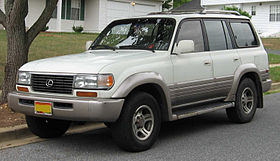 | |
| Overview | |
| Also called | Toyota Land Cruiser (J80) |
| Production | November 1995 – December 1997 |
| Model years | 1996–1997 |
| Powertrain | |
| Engine | 4.5 L 1FZ-FE I6 (gasoline) |
| Transmission | 4-speed A343F automatic |
| Dimensions | |
| Wheelbase | 2,850 mm (112.2 in) |
| Length | 4,821 mm (189.8 in) |
| Width | 1,930 mm (76.0 in) |
| Height | 1,869 mm (73.6 in) |
1995–1997[edit]
Rapidly developed in the mid-1990s as a result of threatening US trade sanctions on Japanese luxury cars, the LX 450 started production in November 1995 and was released to the US in January 1996 as a 1996 model; Canada received the LX from 1997. The LX 450 was Lexus's first SUV and was almost entirely based on the sixth generation Toyota Land Cruiser (J80). Differences lay in a restyled, more luxurious interior and softer suspension settings. The first LX 450 rolled off the production line in December 1995.
The LX 450 was powered by a 4.5-liter, twin-cam, four-valve inline-six engine that produced 160 kW (215 hp) and 373 N⋅m (275 lb⋅ft) of torque. Both front and rear axles were solid. Externally, the LX 450 was identical to the J80 series Land Cruiser, with the exception of the grille, side body cladding, and wheels. Side running boards give step-up access. The vehicle had additional sound-absorbing insulation.
Amenities included leather seats and seating for seven passengers in three rows, the third row accessed by tilting the second row bench seat forward. The third row could be folded to the side and the second row folded down for further space. The vehicle was pre-wired for the Lexus remote telephone system, and had a remote entry key system. The three options consisted of a console-mounted 6-disc CD changer, electronic front and rear locking differentials, and a power moonroof. At the time of its sales debut in early 1996, the LX 450 was listed in the US at a suggested base price of $47,995, an approximately $7,000 premium over the Land Cruiser, with a base price of $40,678 in 1996.
Targeted against luxury SUV competitors such as Range Rover, the LX 450 sold over 5,000 units in 1996 and over 9,000 units in 1997. At its launch it sold out its initial production allocation, resulting in a two-month wait list, surpassing initial expectations which had called for 4,000 units that year. It was brought to market as US buyers showed greater interest in large SUVs, which had grown popular because of their high driver's vantage point and truck-like characteristics. Lexus customer research revealed that one in six owners were purchasing large SUVs to add to their garages. An additional factor was the US-Japan trade war of the mid-1990s. The US government threatened to place 100 percent tariffs on all Japanese luxury import cars, but not including SUVs. The LX 450 was produced as a rebadgedmodel (in contrast with other Lexus efforts which were independently or divergently developed from Toyota vehicles), giving a model that was exempt from the tariff. Ultimately a gentlemen's agreement was reached and the threatened tariffs did not materialize.
The LX 450 replaced the Land Cruiser in the Canadian market starting after 1996, reducing internal competition (big expensive SUVs have traditionally faced a difficult market in Canada) and avoiding the issue of selling a rebadged model (except for GM, Ford and Chrysler, rebadged models in Canada have not met with success). For a 5,000 lb (2,300 kg) vehicle, the LX 450 was regarded by some critics as underpowered, leading to the shortening of its model cycle (despite sales increases) and replacement with a V8-powered successor.
The LX 450 was the top-ranked full-size SUV in J.D. Power and Associates' Initial Quality Survey, with the lowest number of problems during the first three months of ownership.
Second generation (J100; 1998–2007)
| Second generation | |
|---|---|

2002–2005 Lexus LX 470
| |
| Overview | |
| Also called | Toyota Land Cruiser (J100) Toyota Land Cruiser Cygnus (J100) |
| Production | 1998–2007 |
| Model years | 1998–2007 |
| Designer | Hiroya Kitazumi (1995, facelift: 2000, second facelift: 2003) |
| Powertrain | |
| Engine | 4.7 L 2UZ-FE V8 (gasoline) |
| Transmission | 4-speed A343F automatic 5-speed A750F automatic |
| Dimensions | |
| Wheelbase | 2,850 mm (112.2 in) |
| Length | 4,890 mm (192.5 in) |
| Width | 1,941 mm (76.4 in) |
| Height | 1,849 mm (72.8 in) |
1998–2002[edit]
In the mid-1990s, work started on a Lexus variant of the Toyota Land Cruiser (J100), the LX (J100). The final design by Hiroya Kitazumi was approved in 1995, with updates by Kitazumi approved in 2001 and 2004. Testing was conducted from the mid-1990s till late 1997. In December 1997, the second generation LX 470 debuted at Los Angeles Auto Show, going on sale in the second quarter of 1998. It shared the floor plan and most body panels with the equivalent Land Cruiser, and differed in its front appearance and had a more luxurious interior. Exterior design differences included a quad-headlamp forward fascia with larger grille and different wheels. It was powered by a LEV-certified 4.7-liter V8 engine, which initially produced 172 kW (230 hp), later upgraded to 175 kW (235 hp), then 200 kW (268 hp). The final torque value was 445 N⋅m (328 lb⋅ft). It was rated to tow 2,900 kg (6,500 lb) with the tow package installed.
The front gained independent suspension, and the optional electronic locking front and rear differentials were dropped. Suspension included Adjustable Height Control (AHC) hydraulic suspension and Adaptive Variable Suspension (AVS). The AHC could raise the vehicle for off-roading and return to a normal driving height reducing the center of gravity and wind resistance. The lowest setting for when the vehicle was stopped allowed for easier entry, exit and loading. AVS alters shock absorber firmness in under 2.5 milliseconds at each wheel, individually selecting from a range of 64 settings depending on road conditions and driver input such as steering-wheel activity, braking and acceleration. The AVS system used a switch for the driver's preferences including "normal", "comfort" and "sport" modes.
A DVD-based navigation system, Nakamichi stereo with in-dash six-disc CD changer, electrochromic power folding side mirrors, and a smog sensor for the HVAC system were offered. For 2000 models, Vehicle Stability Control and brake assist were made standard.
The Lexus LX 470 was perfectly timed to ride the wave of full-size SUV sales that had swept over the entire car industry, and it became one of the high water marks of the entire sport-utility phenomena. SUV aficionados were impressed with the level of utility provided by the vehicle, in terms of both its towing capacity and its prodigious ability off the beaten path. City dwellers saw the LX 470 as the perfect urban assault vehicle, a safe, luxurious tank that could protect their families from the rigors of daily driving while providing a commanding view of the road and a ton of cargo space to haul as many soccer balls as a team might possibly need at practice.
This article focuses on the 1998 - 2007 Lexus LX 470, the best used full-size sport-utility vehicle to have been produced by the Japanese luxury company.
1998 - 2007 Lexus LX 470
The 1998 - 2007 Lexus LX 470 features styling which some might label brutal, but it is certainly more refined than the Toyota Land Cruiser it is based on. A re-worked front fascia, new headlights and more rounded edges help to soften the utilitarian look of the LX's Toyota origins, giving the SUV a sort of quiet dignity. The LX 470 makes an excellent counterpoint to the Chevrolet Suburban and the Ford Expedition, exerting the same amount of strength and muscle without the crippling length.
The Lexus LX 470 is favored with a 230 horsepower, 4.7-liter V-8 engine that also produces 320 lb-ft of torque. This allows the vehicle to tow up to 6,500 lbs, which is more than enough to handle a boat or camping trailer during fun weekend excursions. In 2006, the engine was massaged in order to boost output by 40 horsepower and 12 lb-ft, making this the year to target for those who enjoy a more responsive throttle. The 32-valve engine found in the LX 470 was a rarity when it was first introduced, and Lexus was one of the first companies to insist upon investing in the technological development of its truck motors instead of relying on older pushrod designs. Each edition of the SUV uses a 5-speed automatic transmission and comes with full-time four-wheel drive.
Cargo space in the 1998 - 2007 Lexus LX 470 is marginally larger than the RX 330 crossover vehicle, coming in at 90 cubic feet. However, this 8-seater blows the smaller SUV away when it comes to passenger capacity, despite the fact that the vehicle is actually shorter than the company's full-size sedan. Voice-controlled DVD navigation is optional on later models of the truck, and all LX 470's come equipped with supremely comfortable leather seats, power rear quarter windows and enough rear seat room to keep complaints to a minimum when transporting a full complement of passengers.
The 1998 - 2007 Lexus LX 470 is a used full-size SUV that helped to define the entire luxury segment, and its winning design makes it worthy of a test drive from anyone interested in a powerful and capable passenger truck.










Since our earliest moments as tiny toddlers, we learn that newer things are generally better than their predecessors. We're constantly getting new phones, remodeling our homes and buying new cars. Newer items are typically more efficient, practical, capable and nicer to look at -- with the exception of a child's favorite blanket or an especially loved stuffed animal, items that seem to become better with age.
But does the sentiment "newer is better" ring true in the car world? We rounded up two examples of Lexus' version of the Toyota Land Cruiser -- the 2006 Lexus LX 470 and the 2016 model -- one of the most durable, timeless vehicles on the market. The differences are mostly down to bodywork and a few features and options. We spent some time driving the two back to back in order to see what we thought.
In one corner, we have the 2006 model -- an excellent example of the model's 100 series, which was sold from 1998 to 2007, that's owned and loved by one of our Autotrader staffers. In the other corner, we have a 2016 Lexus LX 570, recently face-lifted with a bolder, more aggressive look and filled with an almost unending array of today's latest gadgets and features. Here's what we think.


How Much?
Before we get started, we should cover one of the most important questions in any comparison test: How much do these things cost? The 2016 LX 570 starts at $89,900 and offers only a few options, including a Luxury package ($1,190) with improved trim and upholstery, a dual-screen rear entertainment system ($2,000), a full-color heads-up display ($900) and a Mark Levinson surround-sound audio system ($2,350) with -- this is completely true -- 19 speakers. All told, you'll probably spend over $90,000 for one, and you might be into the six figures once you add on taxes and fees.
Considering the LX 470's age -- it's now a decade old -- you might think it'll be cheap to find and buy, but it isn't. There are only 35 different 2006 models listed on Autotrader across the country, and their average price is nearly $22,000. Compare that to the LX's closest competitor back in 2006, the Range Rover, and you'll find nearly 250 examples listed on Autotrader with an average price of just over $16,000. In other words, the LX is hard to find and it holds its value well.


The Similarities
It's important to understand exactly what makes these trucks similar. They're both full-size SUVs, for sure, but it isn't just that. On paper they have a lot in common, from a huge V8 under the hood (it's a 275-horsepower 4.7-liter in the old model and a hulking 383-hp 5.7L in the new one) to a comfortable ride, a smooth-shifting automatic transmission, unique fold-up rear seats, an advanced 4-wheel-drive system and (it's worth noting) abysmal fuel economy. The LX 470 returned 12 miles per gallon in the city and 15 mpg on the highway, while the 570 doesn't do much better at 13 mpg city/18 mpg hwy. However, the new version does deliver over 100 hp more and gets slightly better fuel economy.
Indeed, executives at parent company Toyota know a winning formula when they see it, and these high-dollar, highly capable SUVs aren't subject to many major changes or experiments. It seems that Lexus -- and their customers -- like the SUV exactly how it is.


Gadgets and Technology
With that said, there's no question the LX is evolving, even if two models separated by 10 years have a lot in common. And the most obvious differences relate to the SUV's gadgets and technology.
Yes, the LX 470 was an advanced vehicle when it was on sale, but by modern standards, and especially Lexus LX standards, it's a dinosaur. Here's a list of some of the items you'll find in an LX 570 but not an LX 470: a wireless charging tray, a heads-up display, a 19-speaker stereo system, a 12.3-inch center display screen, Lexus' Enform infotainment system with app capability, USB ports for music, a 360-degree camera system, a power-folding third-row seat, ventilated seats, heated rear seats, adaptive cruise control, lane-departure warning -- and on and on and on. So if technology is your thing, the answer to the question we posed in the title is simple: Yes, newer is always better.
You could say the same for safety, too. While the old model offered virtually everything you'd expect at the time, it lived in a world where forward-collision warning was still an idea in an engineer's mind. While the old LX 470 -- a full-size SUV with a full complement of airbags and a few electronics designed to keep you on the road -- won't exactly kill you, only a few modern vehicles strike us as safer than the new LX 570. Once again, if safety is a priority, you'll answer yes to the question we asked in the headline.


On the Road
And yet, with all the improvements on the inside, it seems like there's something missing when you're behind the wheel. Sure, the new model has 108 more hp than the old one. It also has 71 more lb-ft of torque (332 vs. the new model's 403) and three more gears on the transmission. But everyone who piloted the 2016 model back to back with the 2006 version seemed to have the same opinion: The old one feels better.
One reason is undoubtedly the grand heft of the new one. While the LX 570 is only 5 inches longer than its predecessor, that doesn't tell the whole story. It's wider. It's taller. In an era when cars are getting lighter, it's a whopping 500 pounds heavier. And, most important, it just feels more insulated from the road than the outgoing model. More comfortable? Maybe. But you also feel like you're less sure of what's going on around you, thanks to wider fenders, a bigger, taller hood and continuously shrinking window openings in the name of style.
Floor the accelerator, and you'll notice it most of all. The new one -- the one with the 108 extra hp, 71 more lb-ft of torque and three more gears -- somehow manages to feel slower than the outgoing model because it further insulates you from the speed and from the road. Is this a good thing? Car enthusiasts interested in road feel and obsessively hyperaware of their surroundings will probably say no. People who spend $90,000 on a luxury SUV, however, may feel differently.


Our Take
On paper, everything about the 2016 Lexus LX 570 is better than everything about the 2006 Lexus LX 470. It's more powerful, more efficient, roomier for passengers and cargo, better equipped and chock-full of an enormous amount of extra gadgets, equipment, safety features and luxury amenities. It also looks more modern -- inside and out -- and offers a smoother, cushier ride.
But there's something we still love about the old LX 470 that we wouldn't say about, for example, an old Camry in comparison to a new one. The old LX comes from a different era -- one when the design was about function rather than form (compared to the brash, look-at-me styling of the new version), the driving experience favored road feel rather than comfort, and the Toyota engineers were scratching their heads to figure out how to add extra ground clearance rather than extra stereo speakers.
Yes, there's no doubt that the new LX 570 is the better vehicle. But the LX 470 might just be the better overall experience. It's the worn child's blanket we've come to know and love and can't seem to give up, even when the alternative is 800-thread-count sheets.

2001 Lexus LX 470Handout
Toyota seems to want to rival Ford as the most prolific marketer of sport-utility vehicles. With a brand new ad campaign proffering the rhetorical question, “You belong outside”, the Japanese automaker is trying to bring attention to its SUV lineup that now includes the RAV4, Highlander, 4Runner and the huge Sequoia.
Sitting atop the heap is the LX470 from the company’s luxury arm, Lexus (its other sport ute is the RX300). Big, broad-shouldered and muscular, there’s nary a wimpy body contour to be found, Lexus seemingly having traded in its “relentless pursuit of perfection” tagline for a more Marine-like “see the road, take the road.”
Nonetheless, there’s still a lot of traditional Lexus attributes to be found. For one thing, the new 4.7-litre engine shares its roots with the LS400’s 4.0-litre V8. In fine Toyota tradition, however, it has been completely reworked for duty in the ultra-ute and this 230 horsepower, four-cam, 32-valve bruiser is an all-truck engine.
First, the block is constructed of plain old iron instead of aluminum. Lexus judged the heavier metal more adept at handling the rigors of off-road use. And although it has less horsepower than the variable-valve-timing-equipped GS400, the LX470 has an overwhelming 320 lb.-ft. of torque, peaking at a low 3,400 rpm. Lexus claims that this is sufficient to shift the LX’s 2,450 kilogram (5,401 pound) bulk to 100 km/h in a mere 10.1 seconds.
The LX’s main attraction lies elsewhere, however, with Lexus’ first use of an automatic height control (AHC) suspension. Gas-filled springs in each shock absorber are controlled by an electric pump that raises and lowers the vehicle according to the driver’s inputs.
For easier access and egress, AHC can lower the front by 40 mm and the rear by 50 mm when the 470 is stopped. At five km/h, the AHC system then returns the LX to its normal driving position. AHC can also raise the suspension to provide the ground clearance required for serious off-roading, though it’s doubtful that anything costing as much as the LX470’s $90,100 will ever see anything more dangerous than a cottage fire road.
But if someone decides to get down and dirty, the Lexus does have full-time four-wheel drive with a limited slip differential. A two-speed, full-time transfer case is also standard, while locking front and rear differentials are optional. Completing the off-road package is the LX470’s anti-lock braking system that operates in both high and low (4WD) ranges and is hydraulically boosted (instead of the more common vacuum-boosted versions) for more reliable operation.
Height control is just part of the LX470’s advanced suspension. Using the AVS active variable suspension system pioneered on last year’s ES300, the LX continually adjusts each variable-rate shock absorber through a range of 16 settings. Vehicle height, vehicle speed and steering angle sensors feed driving information to a computer that can change shock settings every 2.5 seconds. AVS is also controlled by driver input with a four-setting switch mounted in the centre console.
For this much money, though, you want a whole heck of a lot more than a truck than can emulate a motocross bike. I’m talking, of course, about creature comforts, something that Lexus has more than a passing knowledge of.
Inside is a leather and wood trim environment that would make a cabin cruiser jealous. A power tilt and telescope steering wheel, memory for the driver’s seat and outside mirrors and a smog sensor with filter are all standard, as are front and rear air conditioning vents. There’s even a third row of seats, meant for the tykes, that folds up against the sides of the interior, or that can be removed completely.
As convenient as those seats are for situations when you’re transporting an entire brood, they do create the LX’s major failing – a paucity of trunk space when that third row is upright. I barely fit a couple of medium-sized travel cases back there and a hockey bag would be out of the question. If you’re thinking of hauling any cargo at all, the last row of seats becomes an early casualty.
The big news for 2001 is the brand-new Mark Levinson stereo. Levinson is the upscale arm of Harmon Kardon, itself a fairly tony brand of audio system and the new boom box replaces the Nakamichi system that has long been part of the Lexus image. Lexus claims its on-board system is so special that it has the first speakers Mark has ever designed. (Previously, Levinson systems were comprised simply of the amplifying system. Owners had to find their own speakers)
I always rated the Nakamichi system as the best in the biz, but Lexus Canada officials insist that the new 400-watt system is superior. They may be right. There just might be a smidgen more bass to the Levinson system, but the only way I can tell is by measuring the flow of blood out of my ears when I turn up the Troggs full blast. It’s the only loud thing in the cabin, though, because very little disturbs the LX470’s calm.
Along with a ride that’s smooth by any standards, not just SUV standards, there’s precious little road noise that reaches those ensconced inside the LX. In this regard, the Lexus is in a league of its own. As it is in most other regards.
Other than a Range Rover, nothing has the Lexus’ combination of pedigree and luxury. BMW’s X5 and Mercedes ML55 are equally costly, but trumpet performance rather than luxury and off-road ability. It’s a unique combination, one that coddles its occupants while beckoning them to the great outdoors. And it has that killer stereo.







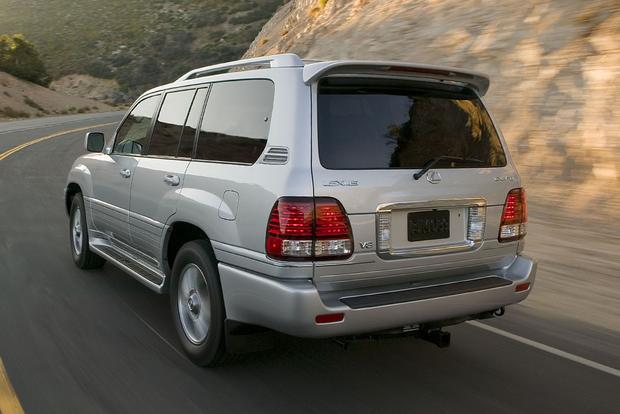

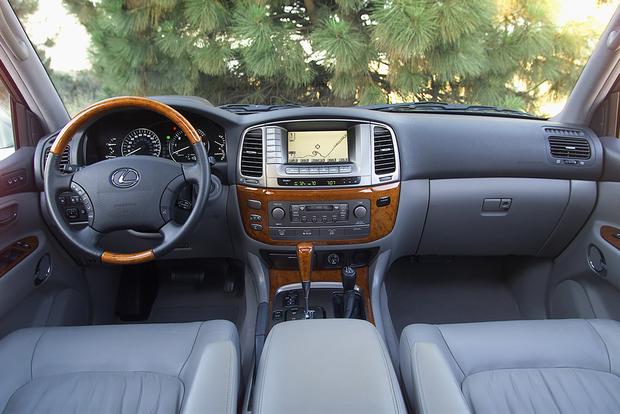
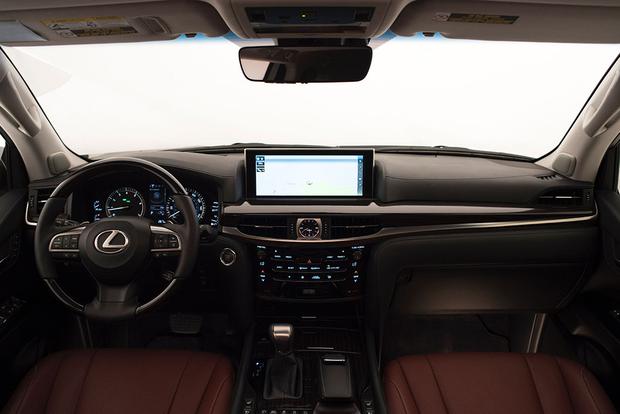

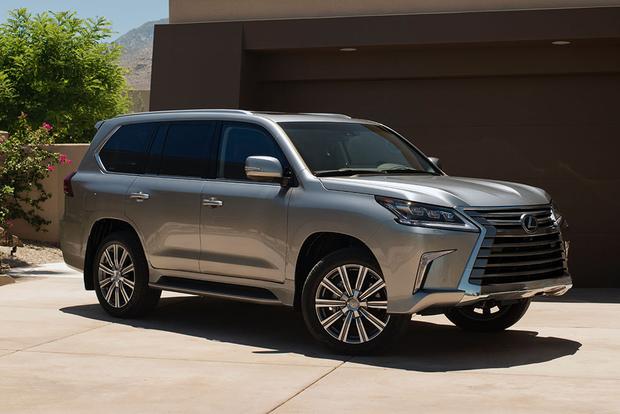
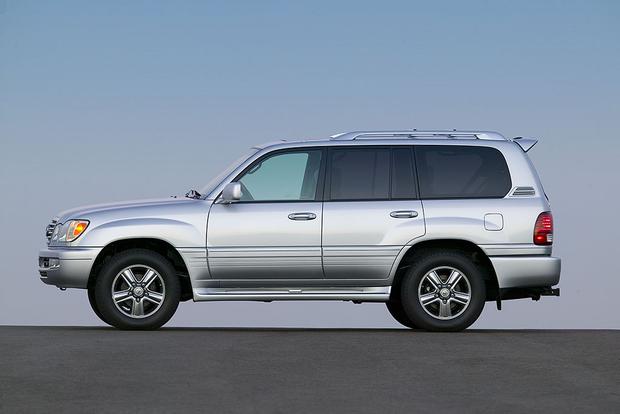
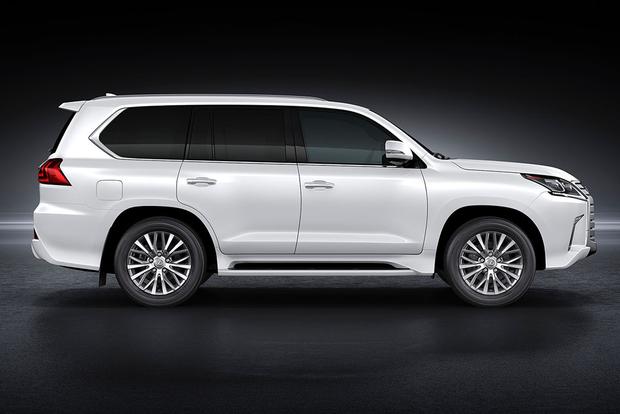
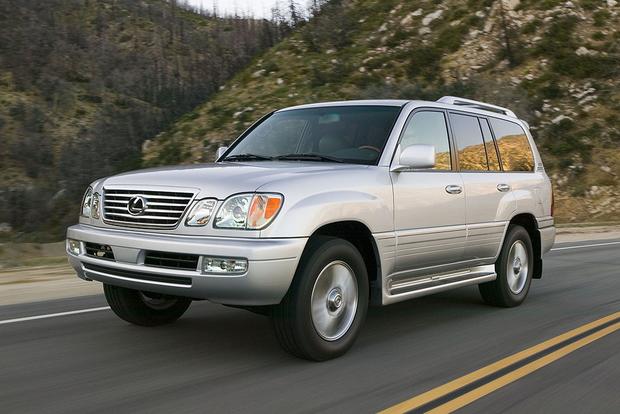










No comments:
Post a Comment